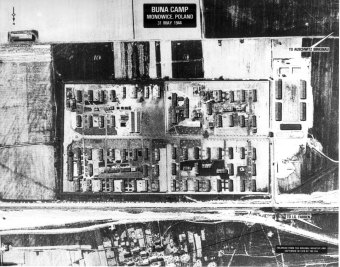Establishment of the Buna/Monowitz Concentration Camp

© Fritz Bauer Institute
As early as October 21, 1941, Walther Dürrfeld, the plant manager of I.G. Auschwitz, submitted to the camp commandant of the Auschwitz concentration camp a proposal for housing, directly on the company’s site, all the 4,000 to 5,000 prisoners slated for use in building the chemical plant in 1942. This venture on the part of the I.G. managers was tantamount to a demand for construction of a subcamp. The commandant of the Auschwitz concentration camp, Rudolf Höß, professed himself unable at that time to comply with the management’s wish, owing to shortage of guards and resources. Even so, an agreement was reached for permanent accommodation of 200 prisoners from the Buna external work detachment in two Reichsarbeitsdienst (RAD, Reich Labor Service) barracks at the construction site in the immediate vicinity of the large buildings made of ready-mixed concrete.
The policy decision to erect a corporate concentration camp on the plant grounds was agreed upon by the I.G. Auschwitz management and the concern’s top leadership in late 1941/early 1942. On January 8, 1942, the Technical Committee of I.G. Farben, which was responsible for the allocation of loans, approved an application including the financing of what would become the Buna/Monowitz concentration camp, labeled in-house as “Camp IV.” In March 1942, the construction management of I.G. Auschwitz began the building of the camp–that is, even before receiving approval from the camp commandant of the Auschwitz concentration camp for erection of the subcamp on the plant grounds. The formal agreement of the camp commandant to the conversion of “Camp IV” to a concentration camp was obtained by the I.G. management in late June 1942. Later it was given the name “KZ Buna” or “Konzentrationslager Monowitz,” Monowitz concentration camp.
On July 17 and 18, 1942, Himmler made a two-day inspection trip to Auschwitz, during which he also had the I.G. construction management brief him on the ongoing construction work for the chemical plant. Shortly thereafter, the SS imposed a camp curfew in Auschwitz because of the acute threat of typhus infection. The abrupt loss of at least 2,000 prisoners from the Buna external work detachment greatly exacerbated the manpower shortage prevailing at the plant construction site since late July 1942 and paralyzed portions of the construction site. Not until the Organisation Todt lent support to the building of the concentration camp in mid-August 1942 did the work speed up once more. Nonetheless, completion of the camp was delayed for weeks by problems in delivery of wire mesh and barbed wire.
For a subcamp, the Buna/Monowitz concentration camp was unusually large in size. On September 23, 1942, the head of the SS-Wirtschafts- und Verwaltungshauptamt (WVHA, Economics and Administrative Main Office of the SS), SS-Obergruppenführer Oswald Pohl, visited Auschwitz and was briefed by I.G. Farben executive board member Otto Ambros on the progress of the construction work. At this meeting, Pohl held out the prospect of supplying the requested inmates by October 15, 1942, the expected completion date of the camp. In the Auschwitz main camp, the first transport with prisoners from the Buchenwald concentration camp arrived on October 19, and from their numbers the SS selected slave laborers for the I.G. Farben construction site. In late October 1942, the first prisoners were shifted to the Buna/Monowitz concentration camp.
(FS; transl. KL)
















